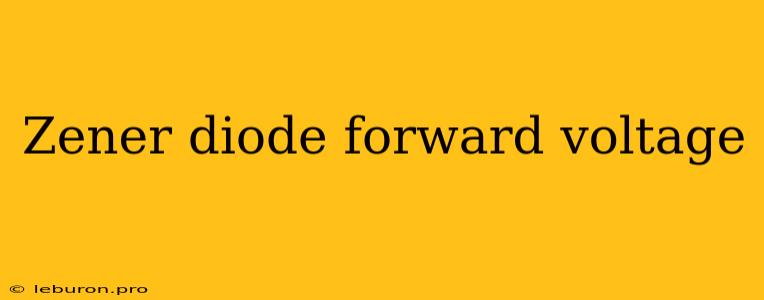Zener diodes are semiconductor devices known for their unique ability to maintain a constant voltage across their terminals when reverse biased, even as the current through them changes. While they are commonly used in voltage regulation and clamping circuits, understanding their forward characteristics is crucial for efficient design and application. This article delves into the forward voltage of a Zener diode, exploring its significance, measurement, and impact on circuit behavior.
The Forward Bias of a Zener Diode
Unlike their reverse bias operation, where they exhibit a breakdown voltage, Zener diodes behave like regular diodes when forward biased. In this configuration, the anode is connected to a positive voltage, and the cathode to a negative voltage. As the forward voltage increases, the diode allows current to flow through it, similar to a regular diode. This forward current is primarily due to the diffusion of charge carriers across the p-n junction. However, there is a crucial difference in the forward voltage of a Zener diode compared to a conventional diode.
Understanding Forward Voltage
Forward voltage refers to the voltage drop across the diode when it is conducting current in the forward direction. For a typical silicon diode, this voltage is usually around 0.7 volts. However, Zener diodes, due to their unique doping structure, exhibit a higher forward voltage, typically ranging from 1 to 2 volts. This higher forward voltage is a direct consequence of the heavily doped p-n junction in a Zener diode.
Impact of Heavy Doping on Forward Voltage
The heavily doped p-n junction in a Zener diode creates a much higher electric field across the junction compared to a regular diode. This strong electric field results in a higher forward voltage drop, allowing the diode to conduct current at a higher voltage compared to a standard diode. While the forward voltage of a Zener diode is generally higher than that of a standard diode, it remains significantly lower than the Zener breakdown voltage, which is the voltage at which the diode begins to conduct in the reverse direction.
Measuring Forward Voltage
To measure the forward voltage of a Zener diode, you can use a simple multimeter. Connect the positive lead of the multimeter to the anode of the diode and the negative lead to the cathode. Apply a forward bias voltage to the diode, ensuring that the current through the diode is within its rated limits. The multimeter will then display the forward voltage across the diode.
The Forward Voltage Curve
A forward voltage curve is a graphical representation of the relationship between the current and voltage across the diode in the forward bias region. The curve typically exhibits a steep slope, indicating that the forward voltage increases rapidly with increasing current. The curve can be obtained by plotting the forward voltage values measured at different current levels.
Implications in Circuit Design
The higher forward voltage of a Zener diode can influence the performance of circuits using them. Here are some key implications:
- Power Dissipation: The higher forward voltage leads to increased power dissipation within the diode, as the power dissipated is the product of the forward voltage and the forward current.
- Voltage Drop: The higher forward voltage can create a larger voltage drop across the diode, which can affect the overall circuit voltage levels.
- Circuit Efficiency: The increased power dissipation can lower the overall circuit efficiency, as more energy is lost as heat within the diode.
Conclusion
The forward voltage of a Zener diode, while often overlooked, plays a critical role in its operation and circuit performance. Understanding this characteristic is essential for designing and optimizing circuits using Zener diodes. By considering the higher forward voltage compared to standard diodes, engineers can ensure efficient operation, minimize power loss, and maintain the integrity of the intended voltage levels within the circuit. While the primary focus of Zener diodes lies in their breakdown behavior, the understanding of their forward characteristics allows for a more comprehensive design and optimization of circuits utilizing these versatile components.
